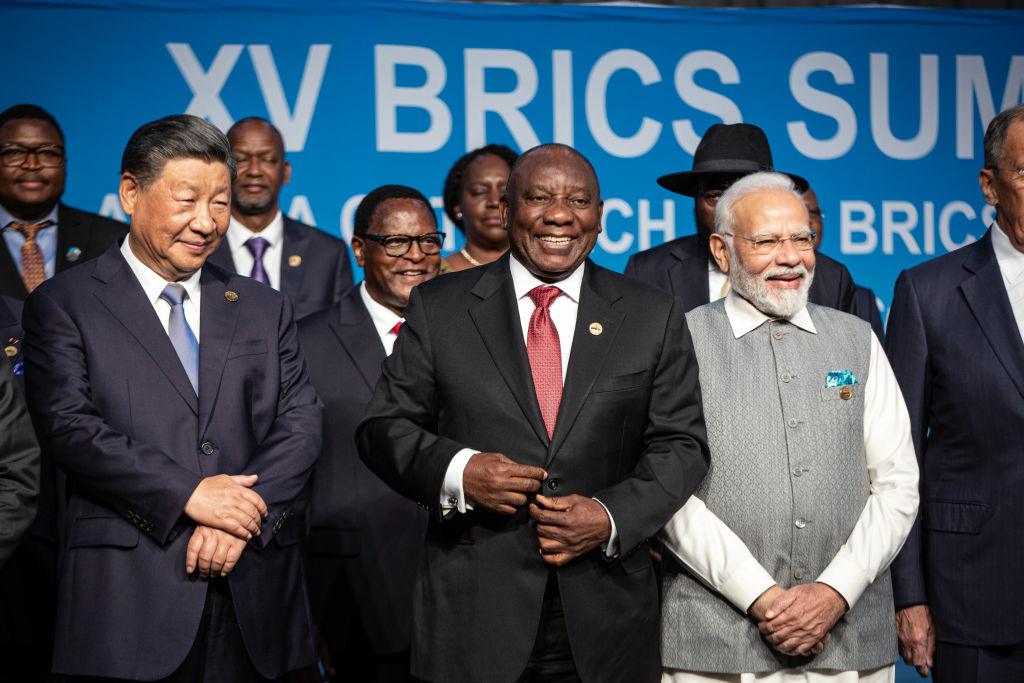 |
|
De-dollarization amid global war was discussed at the BRICS summit in Kazan, Russia The statement also referred to the “devastating impact on economic life of unlawful unilateral coercive measures, including illegal sanctions.” Since the US unilaterally canceled the Iran nuclear deal in 2018 and the outbreak of the Ukraine war in 2022, Washington has cut off Iran’s and then Russia’s access to the US dollar and the related SWIFT international interbank payment system in order to collapse their economies. Amid NATO’s military debacle in Ukraine, Washington is also imposing sanctions on Chinese banks that finance trade with Russia. Threats by Washington and its European allies to seize Russia’s dollar reserves have alarmed many countries in BRICS or likely to join, including Saudi Arabia, which has large dollar reserves from its oil sales but now has close trade ties with China. The Kazan summit therefore decided or considered creating payment systems other than the dollar and financial markets outside US control. “The use of local currencies in financial transactions between BRICS countries and their trading partners” was adopted. “The Russian side’s initiative to establish a grain (commodity) trading platform (BRICS Grain Exchange) within BRICS” was also approved. Currently, most Russian and Iranian oil is traded outside the dollar, primarily with China and India, to avoid US sanctions. The summit declaration also instructed the BRICS interbank cooperation mechanism (ICM) to “examine the feasibility of establishing BRICS Clear, an independent cross-border settlement and custody infrastructure” that could rival SWIFT. Russia and China are also stepping up their purchases of gold, a potential alternative to the U.S. dollar. That’s reportedly critical to keeping the trade going even as U.S. regulators threaten Chinese banks with sanctions for trying to cut off trade with Russia amid the Ukraine war. Last month, in an article titled “Up 601 Percent: Russia Launches Unprecedented Gold-Buying Spree,” the Jerusalem Post noted: Russia and China have developed a new approach to using gold as a means of payment for goods and services. The process involves buying gold in Russia, transporting it to Hong Kong for sale, and depositing the proceeds into local bank accounts. This workaround allows both countries to continue trading while avoiding sanctions.But this alternative method is not without its obstacles: Russian organizations have had to hire couriers to physically transport documents across the border and obtain the necessary approvals from Chinese bankers. Putin commented at a press conference ahead of the summit: “The whole world has begun to think about whether to use the US dollar, because the US, for political reasons, restricts the use of the US dollar as a universal international payment unit.” Putin added that 95 percent of Russia’s foreign trade, and especially 95 percent of its trade with China, is conducted in national currencies, not dollars. Washington and its European imperialist allies are furious at such initiatives. US imperialism has long sought to encourage or force other countries to use the dollar. Especially after the Stalinists dismantled the Soviet Union in 1991, it launched a wave of imperialist wars in the oil-rich Middle East. This is based on financial calculations that go far beyond allowing US and European oil companies to plunder countries like Iraq or Libya. The United States, which has been experiencing a steady decline in its competitiveness, has run huge trade and current account deficits of hundreds of billions of dollars a year for decades. It financed these deficits by sourcing the goods it needed from global industry and printing dollars—often through massive bailouts. Other countries agreed to take these dollars even though they did not need such large amounts to buy U.S.-made products because they were buying other countries’ goods, such as energy or grain, that were sold in dollars in U.S.-controlled markets. US imperialist strategists were therefore determined to avoid exactly the kind of situation that the BRICS summit had set in motion – namely, international trade in critical commodities would be conducted outside the dollar and in markets that escaped US-NATO geopolitical control. This danger was well understood in official NATO circles. In 2019, Saxobank in Denmark published a study on what would happen if Eurasian trade were no longer denominated in dollars, predicting that this would “shift a significant portion of global trade away from the US dollar, gradually reducing the inflows the US needs to finance its double-digit deficits.” It predicted that the US dollar would “lose 20 percent of its value against the average of Asian currencies and 30 percent against gold” within “months.” Indeed, during the BRICS summit, US officials rained threats on the BRICS countries. These were primarily threats aimed at Russia and North Korea, which was accused of sending troops to Russia to fight in Ukraine. They also escalated tensions in the Asia-Pacific by targeting China. “We are seeing evidence that there are North Korean troops heading into Russia,” U.S. Defense Secretary Lloyd Austin told reporters at a press conference in Rome. “If these are co-belligerents — if their intention is to engage in this war on behalf of Russia — that is a very, very serious matter.” “The impact of such a move would be felt not just in Europe but throughout the Indo-Pacific region,” the U.S. Defense Department said. North Korean troops in Ukraine would be “legitimate targets” and could be targeted by US-led forces in Ukraine, White House national security spokesman John Kirby said. This points to the most important weakness of the BRICS summit. BRICS is a coalition of capitalist governments that hope to develop a “multipolar” world order in order to coexist more or less peacefully with NATO imperialist powers, as the Stalinist bureaucracy tried to do before liquidating the Soviet Union. While BRICS seeks a compromise with imperialism, the imperialist powers are extremely reckless and ruthless in pursuing their own interests through genocide and war. They are not after multipolarity, but after world hegemony. The bourgeois regimes in the BRICS countries are also aware that a working class of billions has grown in their countries in recent decades. The presence in Kazan of Sisi, the bloodthirsty Egyptian dictator who is famous for bloodying the revolutionary struggle of the Egyptian workers with his 2013 coup, is only one indication of their hostility towards the workers. The summit declaration also called for an “IMF with sufficient resources” to impose austerity on workers in BRICS candidate countries such as Pakistan and Sri Lanka. Putin argued at a press conference ahead of the summit that BRICS brings countries together on the common ground of capitalism and traditional beliefs. “All of our so-called traditional values, such as Chinese culture, Christian culture, Islamic culture, are actually the same when translated and read from one language to another,” Putin said. Among workers in the BRICS countries, as in NATO countries, there is a common opposition and anger at NATO’s threats to invade Ukraine to fight Russia, or NATO’s support for Israel’s genocide in Gaza. But this does not make the perspective of building a “multipolar” capitalist world a valid perspective for opposing imperialism. BRICS is a coalition of regimes that share a deep awareness of the mortal threat posed by US imperialism and the dominant role of the dollar. It has its own internal tensions that are ripe for explosion. BRICS member or candidate states, such as India and Pakistan or Iran and Saudi Arabia, have repeatedly fought or threatened to fight each other. The only valid perspective for dealing with the relentless escalation of war by the imperialist powers is to build a revolutionary socialist movement within the international working class against imperialist war and capitalism. https://www.wsws.org/tr/articles/2024/10/26/htnz-o26.html? Back |
 Links Search |
||||||
|
|||||||

